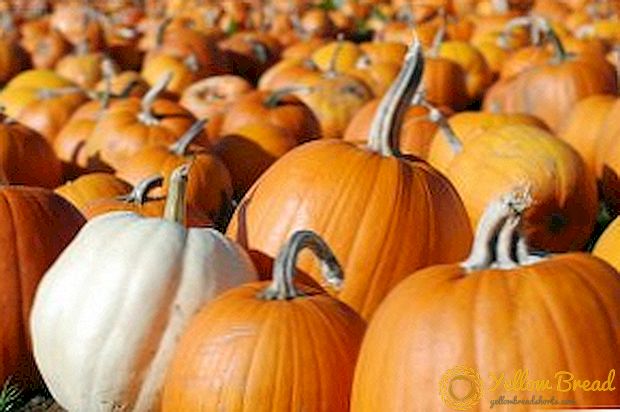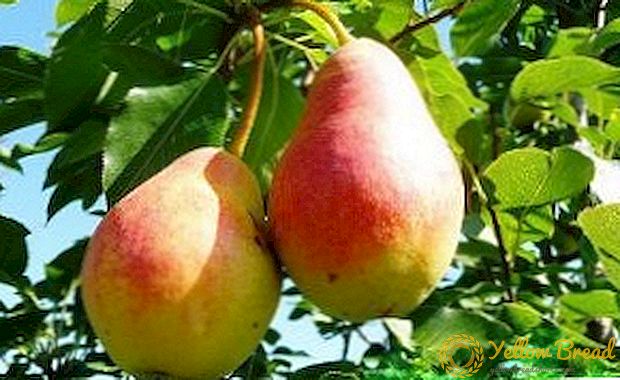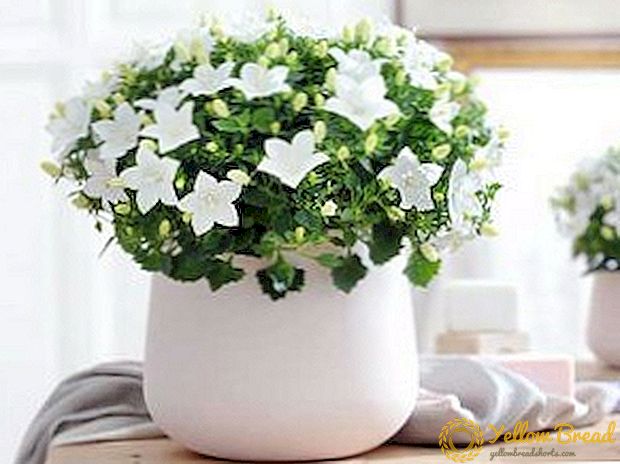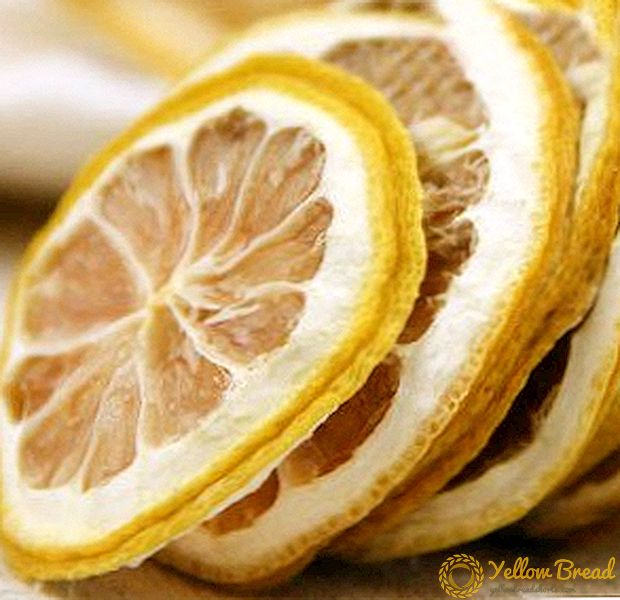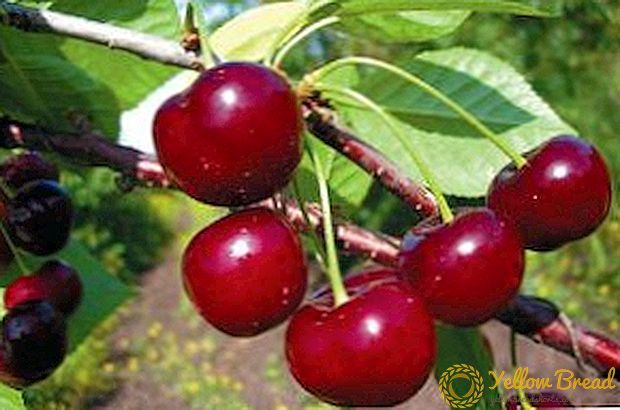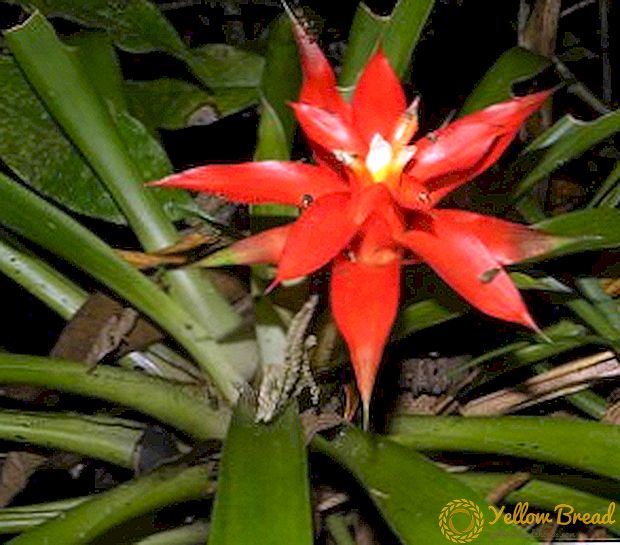 When choosing a variety of tomatoes, many gardeners and gardeners pay attention to the quality and quantity of the crop, the simplicity of the plant to the soil conditions, etc. Those who opted for the variety "Bear Paw", will be able to grow beautiful and tasty fruits without any problems. In this article we will describe in detail about the characteristics and description of the tomato variety "Bear Paw", as well as how to grow such a culture on your own in the country.
When choosing a variety of tomatoes, many gardeners and gardeners pay attention to the quality and quantity of the crop, the simplicity of the plant to the soil conditions, etc. Those who opted for the variety "Bear Paw", will be able to grow beautiful and tasty fruits without any problems. In this article we will describe in detail about the characteristics and description of the tomato variety "Bear Paw", as well as how to grow such a culture on your own in the country.
- Description and Features
- Advantages and disadvantages
- pros
- Minuses
- Self-growing seedlings
- Planting dates
- Capacity and soil
- Seed preparation
- Sowing seeds: the pattern and depth
- Sprouting conditions
- Care of seedlings
- Hardening seedlings
- Planting seedlings on a permanent place
- Terms of transplantation
- Optimal scheme
- Features of care and cultivation agrotechnics
- Watering, weeding and loosening
- Masking
- Garter
- Preventive treatment
- Feedings
Description and Features
This variety of tomatoes is characterized by a lush shape of bushes that have wide spreading leaves. It is thanks to this structure of the bush variety and got its name.The height of the tomato bush Bear Paws can vary from 100 to 200 cm, which is quite impressive by agronomic standards. The fruits of these tomatoes are large, dark red colors, slightly flattened. The average weight of the fruit is 300-500 g, however, some specimens reach 800-900 g. The pulp of tomatoes is dense, fleshy, with extraordinary taste. If the variety is grown according to the correct technology, the yield will be very high. For the season, from one bush can be collected from 8 to 12 tomatoes, and this is about 2-3.5 kg of products.
 "Bear's paw" is a medium late variety. The first fruits of tomatoes can be harvested as early as 112-118 days after planting. The plant tolerates dry soil normally, so in the summer, during rare precipitations, it can grow and develop without problems even without frequent watering. Bush "Bear's paws" forms two tall stalk, which must be tied up. This variety has a good transportability and high commercial qualities.
"Bear's paw" is a medium late variety. The first fruits of tomatoes can be harvested as early as 112-118 days after planting. The plant tolerates dry soil normally, so in the summer, during rare precipitations, it can grow and develop without problems even without frequent watering. Bush "Bear's paws" forms two tall stalk, which must be tied up. This variety has a good transportability and high commercial qualities.
Advantages and disadvantages
Like all other varieties of tomatoes, "Bear Paw" has its positive and negative sides.
pros
Experts identify the following main advantages of this variety of tomatoes:
- The variety is genetically protected from severe drought and heat, and therefore does not need frequent watering;
- Breeders have taken care of the resistance of this plant to the main diseases, so with proper care, they do not appear at all;
- Fruits are large, differ in a bright color and high commodity qualities;
- High yield in kilogram equivalent;
- Excellent taste of the fruit.

Minuses
The disadvantages of the Bear Paw variety are not that many compared to other tomato varieties:
- High spreading bushes that require strong support;
- The fruits have pronounced acidity, and not all consumers of tomatoes like it.
Self-growing seedlings
Growing seedlings of tomatoes "Bear's paw" - the process is not particularly time-consuming, but on its quality will depend on further yields and characteristics of the fruit.
Planting dates
Experts believe that the most favorable month for planting seeds of this variety of tomatoes will be March. In the northern and central regions of our country, planting seeds should be postponed for the middle to the end of the month. In the southern regions, sowing can begin as early as the beginning of the month. It should be noted that some gardeners in the southern regions start sowing seedlings already in mid-late February, but for this it is necessary to be sure that the winter cold will not drag on in the region for a long time. 
Capacity and soil
The choice of capacity will depend on whether you are going to dive seedlings or not. If several seeds are planted at once in large containers, then a further pick will be required, if seed is grown, for example, in disposable cups, then picking will not be necessary (meaning that one seed will be planted in cups). It should be noted that if you are thinking of using disposable cups, then at the bottom you need to make small holes for a stack of excess water. In the store you can purchase special cassette containers for seedlings.There is no particular difference in the capacities; everyone chooses what seems to him to be the most optimal and convenient.
Substrate for planting seeds can be purchased at the store or cook yourself. The soil should consist of equal parts of humus, sod land and river sand. If you do not have humus, then you can replace it with peat, and river sand is replaced with vermicult. 
Seed preparation
Before sowing, it is necessary to calibrate and check all seed material for germination. After that, it is processed by a special means to stimulate growth (Epin, Immunocytophyte, etc.). After processing, the seeds are dried, but in no case are washed.
Some summer residents recommend hardening the seeds before planting by gradually heating. For this, seed is stored throughout the week in places where the temperature regularly rises (from +20 ° C to +80 ° C). At home, the seeds are often quenched on batteries, wrapping them in fabric material.
Sowing seeds: the pattern and depth
The seeds of the Bear Paw need to be planted in a pre-moistened soil to a depth of 1.5-2 cm. If you did not germinate the seeds in advance, the depth should be increased by 30-40%. When planting seed in boxes, the following technology should be observed: the distance between the pits for planting should vary from 2 to 3 cm (this distance is optimal, since you should take into account the fact that after some time the seedlings will spike). 
Sprouting conditions
After planting seed material containers need to be covered with a transparent film or glass, and then remove them in a warm place. It is desirable that natural sunlight prevailed in such a place, although some gardeners use special lamps that stimulate seedling. Usually, the first shoots appear already after 6 days after planting. Then the film or glass needs to be removed and proceed to the next stage.
Care of seedlings
At that moment, when the first shoots appear above the soil, the film is removed, and boxes or cups of seedlings are placed on the south or south-east window sill. The temperature in the room should be stable, since young plants do not tolerate sudden changes in temperature. The temperature should vary from +22 ° С to +24 ° С.
If sunny days in the spring in your area is not enough, then you need to buy a special lamp to illuminate the seedlings. Watering is done only when the top layer of soil dries out a little. Every 5-7 days, the soil around the sprouts should be loosened, only gently, so as not to damage the weak roots of young plants.
 When 2-3 true leaves appear on the seedlings, a pick should be carried out. After picking, transplanted plants are fed with nitrogenous fertilizers. Nitrogen compounds will help the root system of seedlings to settle down faster in a new place and more likely to start active growth. When the first ovaries and flowers appear on the tomatoes, potash and phosphate fertilizers should be applied to the soil.
When 2-3 true leaves appear on the seedlings, a pick should be carried out. After picking, transplanted plants are fed with nitrogenous fertilizers. Nitrogen compounds will help the root system of seedlings to settle down faster in a new place and more likely to start active growth. When the first ovaries and flowers appear on the tomatoes, potash and phosphate fertilizers should be applied to the soil.
Hardening seedlings
Begin hardening tomatoes "Bear Paw" need for 10-14 days before landing on a permanent place. By this time, the temperature around + 11 ... +15 ° С should already be established on the street. Hardening is carried out by keeping the seedlings in the fresh air.The first 2-3 days boxes with crops need to make out on the street in the daytime and leave them there for 1-2 hours. Every day this period of time needs to be increased. 2-3 days before disembarking to a permanent place, seedlings should be left in the fresh air for the whole night.
In addition, for the best quenching of seedlings 5-7 days before planting in a permanent place, it is necessary to reduce watering. But it is important to understand that it is necessary to reduce not the frequency of irrigation, but the amount of water that is added to each plant. 
Planting seedlings on a permanent place
Transplantation of seedlings to a permanent place should be carried out in the right time frame, otherwise there is a risk of losing some seedlings. In addition, when planting should follow a certain pattern.
Terms of transplantation
Experts recommend planting seedlings at a permanent place of growth in May, when the average daily temperature will vary from +16 ° C to +18 ° C. By this time, young seedlings have already reached the age of 60-65 days. Before planting seedlings in open soil, carefully follow the further development of the temperature regime in your area. If in the near future there will be frosts, then it is better to postpone the transfer. 
Optimal scheme
Planting young plants should not be very dense, since in this case the risk of developing various varietal diseases increases significantly. Experts recommend to plant no more than 3 bushes of tomatoes per 1 m². The most optimal scheme for planting Bear's Paws is as follows: conditionally draw a grid of squares in your garden (each of the squares should have 1 meter sides) and plant tomato bushes at each of the corners of the squares. If you use this scheme, then the minimum distance between tomatoes will be 1 meter, which is optimal for such a tall variety of tomatoes.
Features of care and cultivation agrotechnics
If you want to harvest a rich harvest in your tomato plantations, then you need to properly and timely take care of the bushes.
Watering, weeding and loosening
With watering this variety of tomatoes need to be very careful.Frequent watering will cause the fruits to begin to crack. While a lack of moisture can cause yellow or brown spots on the fruit. Watering tomatoes is necessary only at the root in the evening or morning time. Water for irrigation should be at room temperature. Only transplanted seedlings need to be watered every 2-3 days. Under one bush should go 2-2.5 liters of water. Over time, the amount of watering should be reduced, but on particularly hot summer days, the Bear's Paw tomatoes should be watered once every 4 days. 
Immediately after watering, the soil must be compressed with compost, dry nettle or pine needles. Mulching will not allow the soil to thicken; in addition, microorganisms useful for protecting tomatoes will develop under a layer of mulch. If the soil is not mulched in a timely manner, then it is necessary to carry out frequent loosening in order not to form a dense crust of the upper layer of soil.
Weeding is carried out when a large amount of weed appears on a tomato bed, the height of which exceeds 15-20 cm.Weeding should be carried out carefully, without deeply driving a hoe, otherwise there is a risk of damage to the root system of tomatoes.
Masking
Masking is done to prevent the tomato bush from becoming very thick. As you know, dense bushes distribute a lot of nutrients on the layers and leaves, as a result, the fruits can be small and not very tasty. Experts recommend removing the stepsons with their hands or garden shears, which must first be moistened in an aqueous solution of potassium permanganate. Pasying is best done on a sunny day, early in the morning or late in the evening. After the extra stepchildren have been removed, the cuts must be covered with wood ash.  Remove stepchildren need so that the bush does not seem very thick. When the two layers grow very close to each other and are directed in one direction, the larger one is left, and the second is removed. If there are tomatoes with yellowed leaves in your garden, and you suspect that they are afflicted with a disease, then these shrubs become stepsons (otherwise there is a risk of spreading the disease throughout the garden).
Remove stepchildren need so that the bush does not seem very thick. When the two layers grow very close to each other and are directed in one direction, the larger one is left, and the second is removed. If there are tomatoes with yellowed leaves in your garden, and you suspect that they are afflicted with a disease, then these shrubs become stepsons (otherwise there is a risk of spreading the disease throughout the garden).
Often, the stepchildren begin to break off from the end of May, in some regions - from the beginning of June. In addition to the stepsons, it is also necessary to remove the bottom row of leaves. The procedure of pinching is carried out several times during the vegetation period of the plants. It is important to understand that the pinching helps to get large and juicy fruits, so do not neglect the regular removal of excess shoots.
Garter
For garters it is not recommended to use fishing lines, metal wires or thin ropes. The ideal option would be pantyhose or stockings, which do not damage the tall stem of tomatoes. You should also know that every year it is necessary to change the garter, otherwise there is a risk of the spread of varietal diseases.  In order to tie up a tall tomato bush, you need to drive a wooden peg into the ground next to it. The bush is tied around the top of the stem. It is important to monitor the proper stretch of the garter, because if you pull it up, the upper part of the stem can dry out. As the bush grows, the garter can be added upwards, and since the Bear Paw variety can reach two meters in height, it is desirable to tie it up in three places, that is, three times per season.
In order to tie up a tall tomato bush, you need to drive a wooden peg into the ground next to it. The bush is tied around the top of the stem. It is important to monitor the proper stretch of the garter, because if you pull it up, the upper part of the stem can dry out. As the bush grows, the garter can be added upwards, and since the Bear Paw variety can reach two meters in height, it is desirable to tie it up in three places, that is, three times per season.
Preventive treatment
Tomato "Bear paw" at the genetic level is protected from many diseases, but preventive measures are necessary in any case. Before planting, the soil must be treated with a weak aqueous solution of potassium permanganate (1.5% or 2%). A few days after treatment with this solution, the soil is mulched, thus preventing root rot from hiding the bushes.
To prevent the emergence and destruction of the larvae of Colorado beetles and slugs, tomatoes must be treated with an aqueous solution of ammonia. To overcome aphids, the leaves of plants need to be washed with soapy water. To combat volatile insect pests, you can use insecticidal preparations. 
Insecticides allowed spraying only affected tomato bushes and those that are close by. Processing chemicals is carried out strictly according to the instructions for use.
Feedings
For the entire growing season, tomato bushes are fed 3-4 times. Prior to the beginning of the ovary of the first fruits, the main emphasis is on the introduction of nitrogenous fertilizers. When the first fruits are formed, potash and phosphate fertilizers should be applied under the shrub. It should be noted that if we neglect regular feedings, the quality of the fruit and the total yield will significantly deteriorate.
Tomatoes variety "Bear's paw" - the best choice for planting in the country or garden. Its fruits are big, bright and juicy, they will be a great decoration of any holiday table. Observing the basic rules of cultivation and care, you can regularly collect a huge number of large fruits. 

